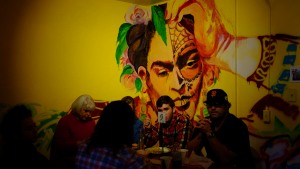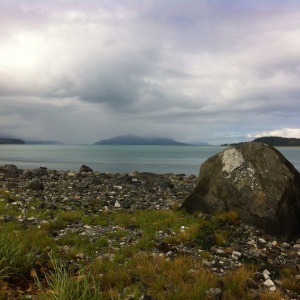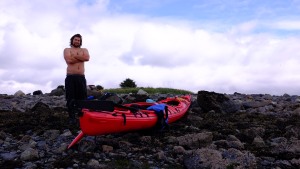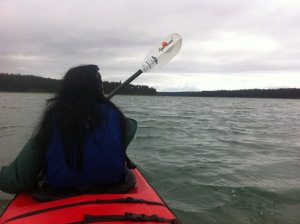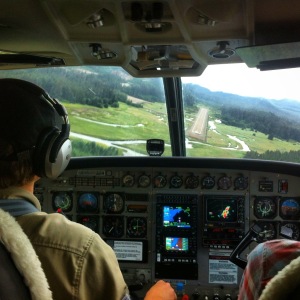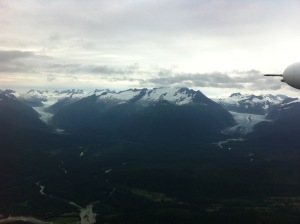(Continued from Part Two which can be found here.)
Juneau was not much different from how we had left it, gloomy, rain-drenched, and spread out like a deconstructed bagpipe. We caught a taxi to the Juneau International Youth Hostel, which in reality was a reasonably priced low-security prison. Upon check-in the woman working the desk, while speaking at a rate of 10,568 words per minute, ordered us to choose a chore that was required to be completed either right this moment or at 7 A.M and stated that we could not leave the hostel after 9 P.M. or we would be locked out. After scrubbing the showers, I was separated from Rejoy and sent to my sexually-discriminant dorm room, where I was greeted by an ambiguous stare from a red haired baby-boomer wearing a beret and the dying groans of a video game character that a Chinese fellow was commandeering on a PC, neither entity acknowledging so much as an audible mumble to my greeting of “Hello.” As I tossed and turned to the animatronic sounds of the Chinese fellow adding funds to his mobile wi-fi account, it was soon daybreak, and at 6:30 A.M. I was awakened with the morning tidings of, “Wake up, the hostel will be closing at 9 A.M.” In a mood akin to kicking a baby, I stormed out of the hostel, mumbling to Rejoy about fascist hostel employees, and grumbled around Juneau in the rain all day, stopping to eat fake, overpriced Mexican food and stare at Alaskan Brewing’s bottling line, feeling like every bottle was being filled with a piece of my brain being extracted and sealed away for future medical experimentation. I had woken up on the wrong side of the bunk bed, and let out a groan of relief when we finally boarded our plane for Gustavus.
Yet, it was not going to be that easy to escape Juneau. As we boarded the 737, I realized we were only two of about ten people, including the flight attendants, on board. “Howdy folks,” came the garbled voice of the captain over the loudspeaker. “We’re gonna have to have you guys spread out to even out the weight of the plane.” The tap-dancing apparitions of airplanes crushed like soda cans began banging their heels on my shoulders. “Now, we’ve got word from Gustavus that visibility is about zero right now, but I think we’re gonna give it a shot.” The anxiety started doing the cha-cha down the flanks of my arms. Yet, in a moment of moronic introspection, I thought to myself, “It’s either this or we’re stuck in Juneau.” Bring on the combustible gases and zero visibility. As we took off, the windows instantly turned into a white nothingness, and I tried to move with the plane, as my stomach kept moving in the opposite direction. To mask the anxiety that was now fully twerking across my entire body, I started up a conversation with a man from Texas, or South Carolina. Or maybe Oregon. To tell the truth I was more concerned with the fact that he looked more nervous than I did. Without much fanfare, after fifteen minutes in the air and a conversation about who knows what, the captain clacked on again proclaiming, “Looks like we’re gonna make it…” and we jerked down into the middle of a runway surrounded by a silent green forest.
Gustavus is the very small community that services Glacier Bay National Park and the surrounding wilderness that encompasses the Kluane/Wrangell St. Elias/Glacier Bay/Tatshenshini-Alsek UNESCO World Heritage Site, the largest roadless area left on the planet. The name is actually pronounced like “Gus Davis,” as if it were named after a chain-smoking, polyester-clad, studio bassist, and not a former king of Sweden. The encompassing mass of area that makes up Glacier Bay was fittingly known by the Tlingits as Sít’ Eeti Gheiyí, or “the bay in place of the glacier,” and the former village on the banks of Bartlett Cove, just a few miles from the current town site, was known as L’eiw Shaa Shaki Aan, or “Sand Mountain Village,” due to the sand dunes that, according to the findings of the Fourth Glacier Bay Science Symposium, commonly occur at the mouth of glacier rivers and would have provided ample protection for the village from “river destruction.” The area is also known for its historic abundance of berries, highlighted by the mass of land now known as Strawberry Island, which was utilized by the Tlingit as a strawberry harvesting ground, and the first homesteaders to the area of current Gustavus coincidentally named it Strawberry Point. As we once again stumbled out of a jet onto a drizzly runway built by the U.S. Army and into a tiny terminal where everyone seemed to know what they were doing except us, we discovered a rehabilitated school bus painted the color of Desert Storm uniforms with “Glacier Bay Lodge” advertised on the side. Tourist-looking people were loading into it like tranquilized school children, and although I had no idea where they had appeared from, we figured it must be the shuttle we had been told would take us to the National Park campground and obediently obeyed the driver to “take a seat,” as if it was our first day of second grade.
When we arrived at the Glacier Bay Lodge after a 20-minute venture through the tiny town and into the rainforest, we then hiked another half-mile into the woods to the ranger station and registered for our camping permit. This entailed watching a video of two sterile-looking kayakers paddling in perfect rhythm with each other, as a dehydrated narrator explained the dangers of the backcountry and the importance of protecting the land. The video really wasn’t that bad, but I was still recovering from my psychological mêlée with the youth hostel and just wanted to see a narwhal jump up and spear the kayakers like a Turkish kabob so we could go make dinner. Finally, with permit in hand, we set up our camp in the middle of a mossy fairyland and drifted away to the sounds of the lapping shore as the nightfall never fully extinguished its ethereal glow.
Waking up to the sun peeking out from behind a distant mountain, we set out to meet with Leah, the kindhearted kayak guide with an Oceanic accent, who provided us with waterproof gear and an enormous, Corvette-red, double kayak with a black, metal rudder controlled by foot pedals. After looking over a plastic-coated map that was slightly blurry and yellowed from not being completely waterproof, we decided we would make an approximate 13-mile loop by kayak, starting in Bartlett Cove near the campground, loop around Lester Island into the open bay, curve east into the heart of the Beardslee Islands, and complete the loop by cutting down the Bartlett River, an undertaking that had to be timed within an hour before or after high tide or else the opening would be impassable. At about 10 A.M. Leah told us to call her when we got back so she wouldn’t have to come searching through the mudflats for us, and we embarked on our nautical quest into Glacier Bay.
After not kayaking for nearly half a decade, the going was rough at first. I forgot that kayaking actually takes work and fitness, and just getting halfway across Bartlett Cove felt like an eternity. Yet bobbing back and forth in the current as the jade colored hillsides sloping up towards the jagged mountains started to appear from out of the mist and the fresh wisps of the sea began splashing my face as we struggled to paddle towards the open bay, I started the feel the aggressive annoyance that I had held on to finally start to dissipate into the water, and the musings of John Muir and the songs of the Tlingit started to resonate again; my energy rejuvenated.
As we skimmed past a fishing boat, we turned north up the west side of Lester Island and were now in the open waters of Glacier Bay. Our kayak began to heave sideways and head high waves started to crash towards us, one specific trickster slamming right on top of Rejoy who was seated in the front. To the right we kept a close proximity to the shore, as to the left swirled a white water abyss, where spun whirlpools of seaweed and seductive sea sirens that seemed to gain more determination at sucking you towards the center of the Earth the closer you got. At first glance, what I thought might have been a kraken tentacle waiting for the perfect moment to smash our humble vessel, in reality turned out to be a lounging harbor seal playing in the eddy. With that, my anxiety of having to explain to Rejoy’s parents why their daughter had been sucked into a ferocious sea chasm subsided, and we giggled as a few more barreling waves smashed against the kayak. With some extra effort, we forced our way around the northwest corner of Young Island and glided joyfully into the calm waters of the Beardslee Islands.
With the most difficult part of the journey over, it seemed the Earth was in accordance that it was time for things to become truly harmonious, and a sea otter cracking a mussel open on his stomach swam by, munching on a mouthful of mollusk. The water had become perfectly calm, and on the beach, blue and green cormorants were resting in a tiny inlet that led out of the forest. All around flocks of marbled murrelets and molting mergansers, like a page out of Dr. Seuss, squawked and glided across the tops of the treetops, and more harbor seals showed up to check out the strange green object that had entered their maritime playground. As I looked out towards the golden glow of Strawberry Island, suddenly the calm waters were torn open and a humpback whale stretched its body across the surface, followed by its gargantuan tail that saluted the sky before slamming back under. The rest of the day, this occurred with musical regularity.
After paddling for nine miles and hoping we were actually paddling in the right direction and not destined for Kamchatka, it was decided we needed to stop for lunch, consult the map, and wait for the tide to rise enough to sneak down the Bartlett River. Our objective was Eider Island, a tiny, treeless piece of land in the middle of the Beardslees that if we could grasp our correct coordinates, we would be set to make it back to Bartlett Cove without a hiccup. I hopped out of the kayak, instantly found myself in water up to my waist, slipped on a few patches of slimy kelp, and lugged the incredibly heavy tomato soup colored sea vessel onto the beach. Looking out into the endless pine-colored wilderness, the whales continued to poke their blowholes out from the surface, sometimes one interested eye meeting my gaze in a moment of pure understanding between two living forces. Black oystercatchers, jack-o-lantern looking birds with protruding orange beaks nearly the same length of their bodies, hurriedly sprinted back and forth across the beach, snatching clam shells and algae that may have darted off if not for the agile and “methamphetamous” movements of their predator. As Rejoy fired up the camp stove to cook Rice-A-Roni, I decided to take a stroll around the circumference of the island to check for any buried treasure that may have been left behind and to be positive we were not on an abandoned zombie refuge.
Within the first few feet of leaving our camp, I noticed a rambunctious group of white birds with miniscule orange beaks and small black helmets begin to take flight and loop in circles as if they were training in vicious preparation for an onslaught of porcupines to come charging at their nesting grounds. Paying little mind, I walked on and noticed my feet were crunching across a killing field of devoured bivalves and invertebrates; the crunched up shells glittered in the cloud-smothered sunlight, like the skulls of beheaded rodents, caught in the carnage of some ghastly beast. I stooped down to pick up a shell that was glittering blue and purple and was suddenly nearly sideswiped by one of the militaristic birds. Its wings curved in an oddly malicious angle, I was dive-bombed by another from the opposite side, its ravenous orange beak open, ready to strike and tear my ear off. I soon became aware that I was under attack by an aggressively territorial group of Arctic terns, seabirds that embark on the longest migration in the animal kingdom, breeding in the Arctic north and flying south to the coasts of Antarctica, forever following the hemispheric summer. Like a scene out of “The Birds,” I could hear Alfred Hitchcock chuckling as I dodged another dive from an evil-eyed raptor ancestor. This was getting serious, and the thought of picking up a piece of driftwood to swat at these feathered fiends and protect my life was now becoming a necessity. I looked up into the darkening sky and nearly shrieked in terror as another Arctic tern with a menacing scowl on its face hovered in mid-air, timing its strike before plunging its talons towards my shirtless back. This was now too much, and I darted towards a large patch of green reeds that made up a small-scale jungle at the center of the island and ducked in the undergrowth for cover, feeling like a G.I. separated from my unit, ambushed by a rogue guerilla death squad. Crawling along a concealed path that took me towards a different section of the island, I came out on the opposite side of the island with my adrenalin racing ready to break the beak off any airborne ogre that might cross my path with my bare hands. I later found out, from a backcountry guidebook by Jim DuFresne, that the “park service urges paddlers to avoid walking on Eider Island,” along with other treeless islands within the Beardslee Islands, to “protect bird colonies.” The guidebook failed to mention you may also want avoid Eider Island to prevent hostile skirmishes involving nesting, ornery Arctic terns, who may mistake you for a titanic seagull.
As I finished my loop around the island, eyeing the oystercatchers’ remote orange eyes with a newfound unease as they seemed to linger closer and closer to our camp stove, I waded into the water to pull our kayak further onto land, as the tide had risen immensely in the past fifteen minutes, pulling our vessel towards the water and almost forcing us to have to swim back to Bartlett Cove. Right on cue, as we began to eat, it started to rain again (it had to keep up the pattern of raining every single day on our vacation) and we reapplied our clammy, damp rain jackets, scarfed down the half cooked rice, and hopped back in the kayak to press onward.
The rest of the paddle was free of angry animals, and as we portaged our kayak across a small piece of land to reach the waterway that would take us south and back to civilization, I knew that, although I had come to Glacier Bay without seeing a single glacier, this was the Alaska that I had sought out, irritable birds and all. We could see the bottom as we paddled along the narrow gateway of the Bartlett River, and as the ferry dock once again appeared in front of us, the afternoon sun stretching a blinding gloss across the cove, I collapsed onto my back, letting the water splash onto my neck, and nearly tipped over the kayak in bliss, as Rejoy commandeered us into port.
That evening Rejoy spotted a black bear, I ate buffalo pie, and then we drifted off into a midnight sun slumber before being rudely awakened by my bell tower alarm clock informing us that it was 4 A.M. and we needed to pack up camp and meet our taxi driver at the dock to catch a ride to the airport.
At 5:02 A.M. a navy blue shipwreck of a van with “John’s Taxi” written across the side proceeded to drive up very near to us, completely by-pass us, and continue driving out onto the dock, appearing as if it were going to drive right into the water. A tiny, tanned man jumped out of the van, which then at full speed in reverse returned back to where we were waiting, and John, a seasoned gentleman in a faded fishing cap with a dangling beard adorned with blotches of salt and cinnamon, stepped out and loaded our bags into the back. The world around us was still gray and waking up, but John gave us a tour of our surroundings, noting how the open grassland we were passing through was often a crossroads for black bears trying to escape shotgun-toting townsfolk and that he didn’t understand why the park service had started to allow more moose hunting, right at the time when the moose population was beginning to level out again after nearly being hunted to extinction in the area. John had lived in California, joining the Coast Guard and getting shipped to the South before winding up in Alaska, where he’s been ever since and doesn’t plan on leaving. At one moment, we stopped in the middle of the road as the engine seemed to be puttering, pondering whether it would continue to run or not, and John took the keys out of the ignition and started fiddling with the wires under the steering wheel, as if dismantling a bomb. With a rumble and a puff, the engine jumped back to life, even without a key in the ignition, and we continued on towards the airport. When we reached the “4 Corners,” one of the only intersections in town and considered “downtown” Gustavus, John pulled into the gas station with pumps straight out of 1956, as the fuel gauge was nearly flat-lined to empty. I half expected a pimple-faced dimwit in a jumpsuit to come running out saying, “Geez whiz Mr., fill ‘er up?” but it was much too early for that nonsense. John explained that the gas station also served as a sort-of old automobile museum and that the gas station was one of the top tourist attractions in Gustavus. As we pulled into the tiny terminal that housed “Wings of Alaska,” John pointed out that our only fellow flier was one of the elementary school teachers, and with a grizzly handshake full of absolute genuineness, John wished us good luck and was gone.
Never fully shedding our “your-obviously-not-from-here” aura, when they called for boarding to Juneau we sat motionless until the girl asked, “You guys coming?” Oh, but we’re not going to Juneau. “Well this is the only flight, so, yeah, you are.” Like a bellowing blackhole, Juneau was calling us back again in order to get back home. As we climbed into the tiny Cessna, the pilot, who I think must have just turned 18, told us, “Grab any seat. Even the co-pilot seat if you want.” As we started to lift off, for some odd-reason, I felt safer in this tiny plane than I had ever felt in a jet, and as we cruised over Icy Straight, the sun came out and laid a blinding gloss over the water, and within 20 minutes we were barreling towards a topsy-turvy landing at the community of Hoonah.
Picking up a few more passengers, we were airborne within five minutes, and the pilot basically answered his own question as, “You guys know this stuff” in response to if we needed to hear the safety guidelines again. Another 20 minutes, and the urban sprawl of Juneau appeared under the mountains, and we were once again weaving and wobbling down to solid ground, this time for a short coffee break, until we reloaded with new passengers and headed up the Lynn Canal towards Skagway. This time, I decided to sit in the co-pilot’s seat and felt like a little kid who was earning his plastic wings pin and would go back to first grade proudly stating “When I grow up I want to be a pilot.” The pilot told me, “Feel free to ask what any of the these buttons and knobs do,” and I definitely did, mesmerized by the blinking lights once again like a first-grader asking, “What does that button do?” and “Does that one make us go faster?” In reality, as the pilot explained things, it didn’t seem to be too difficult, and I even asked, “So if I grab my steering wheel would I be able to fly the plane right now?” He laughed and told me, of course, the plane was designed for two pilots, and that if anything goes wrong he was blaming it on me. Soaring past massive glaciers and over pointy peaks, we made a hard left and made one more stop in Haines, successfully landing in every town that “Wings of Alaska” flies to, except of course for our destination, Skagway.
One more reminder that the fire extinguisher was in the pilot’s door, one more take off as the video game looking GPS blinked and barked, and in ten minutes we were making a blackout-inducing 180 degree turn through the Skagway Valley, coming to a soft and easy landing on the runway of America’s busiest unmanned, international airport.
As we piled our belongings onto the SMART bus, Skagway’s only form of public transportation, the white haired driver, to whom I had spoken with many times before, asked, “So just visiting?”
“Oh no, we live here for the summer. We’re going to 20th and Main.”
“Ok, 18th it is,” and the bus ambled along in the general direction towards our home.


